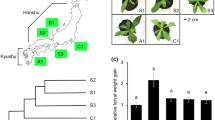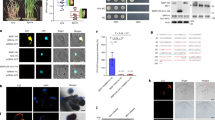Abstract
The discovery in tomato of systemin, the first plant peptide hormone1,2, was a fundamental change for the concept of plant hormones. Numerous other peptides have since been shown to play regulatory roles in many aspects of the plant life, including growth, development, fertilization and interactions with symbiotic organisms3,4,5,6. Systemin, an 18 amino acid peptide derived from a larger precursor protein7, was proposed to act as the spreading signal that triggers systemic defence responses observed in plants after wounding or attack by herbivores1,7,8. Further work culminated in the identification of a leucine-rich repeat receptor kinase (LRR-RK) as the systemin receptor 160 (SR160)9,10. SR160 is a tomato homologue of Brassinosteroid Insensitive 1 (BRI1), which mediates the regulation of growth and development in response to the steroid hormone brassinolide11,12,13. However, a role of SR160/BRI1 as systemin receptor could not be corroborated by others14,15,16. Here, we demonstrate that perception of systemin depends on a pair of distinct LRR-RKs termed SYR1 and SYR2. SYR1 acts as a genuine systemin receptor that binds systemin with high affinity and specificity. Further, we show that presence of SYR1, although not decisive for local and systemic wound responses, is important for defence against insect herbivory.
This is a preview of subscription content, access via your institution
Access options
Access Nature and 54 other Nature Portfolio journals
Get Nature+, our best-value online-access subscription
$29.99 / 30 days
cancel any time
Subscribe to this journal
Receive 12 digital issues and online access to articles
$119.00 per year
only $9.92 per issue
Buy this article
- Purchase on Springer Link
- Instant access to full article PDF
Prices may be subject to local taxes which are calculated during checkout



Similar content being viewed by others
References
Pearce, G., Strydom, D., Johnson, S. & Ryan, C. A. A polypeptide from tomato leaves induces wound-inducible proteinase inhibitor proteins. Science 253, 895–898 (1991).
Ryan, C. A. & Pearce, G. Systemin: a polypeptide signal for plant defensive genes. Annu. Rev. Cell. Dev. Biol. 14, 1–17 (1998).
Tavormina, P., De Coninck, B., Nikonorova, N., De Smet, I. & Cammue, B. P. A. The plant peptidome: an expanding repertoire of structural features and biological functions. Plant Cell 27, 2095–2118 (2015).
Breiden, M. & Simon, R. Q&A: how does peptide signaling direct plant development? BMC Biol. 14, 58 (2016).
Matsubayashi, Y. & Sakagami, Y. Peptide hormones in plants. Annu. Rev. Plant Biol. 57, 649–674 (2006).
Matsubayashi, Y. Posttranslationally modified small-peptide signals in plants. Annu. Rev. Plant Biol. 65, 385–413 (2014).
McGurl, B. & Ryan, C. A. The organization of the prosystemin gene. Plant Mol. Biol. 20, 405–409 (1992).
McGurl, B., Pearce, G., Orozco-Cardenas, M. & Ryan, C. A. Structure, expression, and antisense inhibiton of the systemin precursor gene. Science 255, 1570–1573 (1992).
Scheer, J. M. & Ryan, C. A. The systemin receptor SR160 from Lycopersicon peruvianum is a member of the LRR receptor kinase family. Proc. Natl Acad. Sci. USA 99, 9585–9590 (2002).
Scheer, J. M., Pearce, G. & Ryan, C. A. Generation of systemin signaling in tobacco by transformation with the tomato systemin receptor kinase gene. Proc. Natl Acad. Sci. USA 100, 10114–10117 (2003).
Kinoshita, T. et al. Binding of brassinosteroids to the extracellular domain of plant receptor kinase BRI1. Nature 433, 167–171 (2005).
She, J. et al. Structural insight into brassinosteroid perception by BRI1. Nature 474, 472–476 (2011).
Hothorn, M. et al. Structural basis of steroid hormone perception by the receptor kinase BRI1. Nature 474, 467–471 (2011).
Holton, N. et al. Tomato BRASSINOSTEROID INSENSITIVE1 is required for systemin-induced root elongation in Solanum pimpinellifolium but is not essential for wound signaling. Plant Cell. 19, 1709–1717 (2007).
Lanfermeijer, F. C., Staal, M., Malinowski, R., Stratmann, J. W. & Elzenga, J. T. Micro-electrode flux estimation confirms that the Solanum pimpinellifolium cu3 mutant still responds to systemin. Plant Physiol. 146, 129–139 (2008).
Malinowski, R. et al. The tomato brassinosteroid receptor BRI1 increases binding of systemin to tobacco plasma membranes, but is not involved in systemin signaling. Plant Mol. Biol. 70, 603–616 (2009).
Felix, G. & Boller, T. Systemin induces rapid ion fluxes and ethylene biosynthesis in Lycopersicon peruvianum cells. Plant J. 7, 381–389 (1995).
Ryan, C. A. The systemin signaling pathway: differential activation of plant defensive genes. Biochim. Biophys. Acta 1477, 112–121 (2000).
Eshed, Y. & Zamir, D. An introgression line population of Lycopersicon pennellii in the cultivated tomato enables the identification and fine mapping of yield-associated QTL. Genetics 141, 1147–1162 (1995).
Chitwood, D. H. et al. A quantitative genetic basis for leaf morphology in a set of precisely defined tomato introgression lines. Plant Cell 25, 2465–2481 (2013).
Wang, L. et al. The pattern-recognition receptor CORE of Solanaceae detects bacterial cold-shock protein. Nat. Plants 2, 16185 (2016).
Yoo, S. D., Cho, Y. H. & Sheen, J. Arabidopsis mesophyll protoplasts: a versatile cell system for transient gene expression analysis. Nat. Protoc. 2, 1565–1572 (2007).
Bolger, A. et al. The genome of the stress-tolerant wild tomato species Solanum pennellii. Nat. Genet. 46, 1034–1038 (2014).
Constabel, C. P., Yip, L. & Ryan, C. A. Prosystemin from potato, black nightshade, and bell pepper: primary structure and biological activity of predicted systemin polypeptides. Plant Mol. Biol. 36, 55–62 (1998).
Yamaguchi, Y., Pearce, G. & Ryan, C. A. The cell surface leucine-rich repeat receptor for AtPep1, an endogenous peptide elicitor in Arabidopsis, is functional in transgenic tobacco cells. Proc. Natl Acad. Sci. USA 103, 10104–10109 (2006).
Lori, M. et al. Evolutionary divergence of the plant elicitor peptides (Peps) and their receptors: interfamily incompatibility of perception but compatibility of downstream signalling. J. Exp. Bot. 66, 5315–5325 (2015).
Butenko, M. A. et al. Tools and strategies to match peptide–ligand receptor pairs. Plant Cell 26, 1838–1847 (2014).
Meindl, T., Boller, T. & Felix, G. The plant wound hormone systemin binds with the N-terminal part to its receptor but needs the C-terminal part to activate it. Plant Cell 10, 1561–1570 (1998).
Pearce, G., Johnson, S. & Ryan, C. A. Structure-activity of deleted and substituted systemin, an 18-amino acid polypeptide inducer of plant defensive genes. J. Biol. Chem. 268, 212–216 (1993).
Malone, M., Alarcon, J. J. & Palumbo, L. A hydraulic interpretation of rapid, long-distance wound signalling in the tomato. Planta 193, 181–185 (1994).
Wildon, D. C. et al. Electrical signalling and systemic proteinase inhibitor induction in the wounded plant. Nature 360, 62–65 (1992).
Li, L., Li, C., Lee, G. I. & Howe, G. A. Distinct roles for jasmonate synthesis and action in the systemic wound response of tomato. Proc. Natl Acad. Sci. USA 99, 6416–6421 (2002).
Mousavi, S. A., Chauvin, A., Pascaud, F., Kellenberger, S. & Farmer, E. E. GLUTAMATE RECEPTOR-LIKE genes mediate leaf-to-leaf wound signalling. Nature 500, 422–426 (2013).
Zimmermann, M. R., Maischak, H., Mithofer, A., Boland, W. & Felle, H. H. System potentials, a novel electrical long-distance apoplastic signal in plants, induced by wounding. Plant Physiol. 149, 1593–1600 (2009).
Dubiella, U. et al. Calcium-dependent protein kinase/NADPH oxidase activation circuit is required for rapid defense signal propagation. Proc. Natl Acad. Sci. USA 110, 8744–8749 (2013).
Orozco-Cardenas, M., McGurl, B. & Ryan, C. A. Expression of an antisense prosystemin gene in tomato plants reduces resistance toward Manduca sexta larvae. Proc. Natl Acad. Sci. USA 90, 8273–8276 (1993).
Albert, M. et al. Arabidopsis thaliana pattern recognition receptors for bacterial elongation factor Tu and flagellin can be combined to form functional chimeric receptors. J. Biol. Chem. 285, 19035–19042 (2010).
Van Eck, J., Kirk, D. D. & Walmsley, A. M. Tomato (Lycopersicum esculentum). Methods Mol. Biol. 343, 459–473 (2006).
Maffei, M., Bossi, S., Spiteller, D., Mithofer, A. & Boland, W. Effects of feeding Spodoptera littoralis on lima bean leaves. I. Membrane potentials, intracellular calcium variations, oral secretions, and regurgitate components. Plant Physiol. 134, 1752–1762 (2004).
Acknowledgements
We thank I. Bock and C. Brancato (Tübingen) for technical assistance and T. Boller (Basel) for critical reading of the manuscript. We are grateful for financial support to L.W. and G.F. by DFG-CRC1101-D05 and to M.A. by DFG AL1426/1-2.
Author information
Authors and Affiliations
Contributions
L.W. was involved in designing, performing and analysing of all experiments. H.K. synthesized the acridinium- and biotin-labelled peptides, M.A. contributed to ligand binding experiments in Fig. 2, E.E. to experiments in Fig. 3a,b,c and M.A.-T. and A.M. to experiments with insect larvae in Fig. 3d. L.W., J.F. and G.F. supervised the work, planned the experiments and wrote the manuscript.
Corresponding author
Ethics declarations
Competing interests
The authors declare no competing interests.
Additional information
Publisher's note: Springer Nature remains neutral with regard to jurisdictional claims in published maps and institutional affiliations.
Supplementary information
Supplementary Information
Supplementary Figures 1–7, Supplementary Tables 1 and 2.
Rights and permissions
About this article
Cite this article
Wang, L., Einig, E., Almeida-Trapp, M. et al. The systemin receptor SYR1 enhances resistance of tomato against herbivorous insects. Nature Plants 4, 152–156 (2018). https://doi.org/10.1038/s41477-018-0106-0
Received:
Accepted:
Published:
Issue Date:
DOI: https://doi.org/10.1038/s41477-018-0106-0
This article is cited by
-
Phylogeny of the plant receptor-like kinase (RLK) gene family and expression analysis of wheat RLK genes in response to biotic and abiotic stresses
BMC Genomics (2023)
-
Endocytosis-mediated entry of a caterpillar effector into plants is countered by Jasmonate
Nature Communications (2023)
-
Mechanisms controlling plant proteases and their substrates
Cell Death & Differentiation (2023)
-
The secreted PAMP-induced peptide StPIP1_1 activates immune responses in potato
Scientific Reports (2023)
-
Plant Peptides Involved in Abiotic and Biotic Stress Responses and Reactive Oxygen Species (ROS) Signaling
Journal of Plant Growth Regulation (2023)



